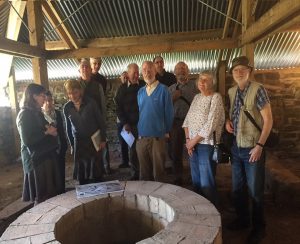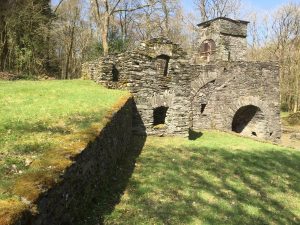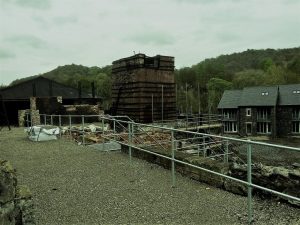Diary of a visit to some blast furnace sites in the Lake District
Friday 20th April.
An horrendous drive up the M6 to our rendezvous at the southern end of the Lake District. Arrived at the house rented for the week-end, meeting up with other WIRG members. Looking forward to seeing the sites that are on the planned itinerary. This has been organised by Tim Smith, Kay Smith and Ruth Brown. Kay and Ruth have done a reconnaissance in preparation and expectations are high. My personal objective is to make a critical comparison of different charcoal-era furnace types.
Sat. 21st.
Up at about 7.30. A convivial breakfast with other members. We set out in various cars. First stop: Newland Furnace. This is a very late charcoal furnace that was closed down in 1890. It is in the care of the Newland Furnace Trust, three of whose members met us and gave us the benefits of their hard-won knowledge of the site.

An oddity of this site is that a hot-blast system was installed at a relatively late date. Together with the fact that it was changed from bellows-blast to cylinder-blast makes the interpretation of some of the buildings difficult. The boshes and the hearth are missing, but most of the super structure remains in place. The huge (and hugely impressive) charcoal store is still in place and, appropriately enough, is now used as a store by a coal merchant.
Lunch at the friendly ‘New Kings Head’, Broughton-in-Furness. They serve the well kept and well-flavoured ale from the Cross Bay Brewery in nearby Morecambe.

Then on to Duddon Furnace. This is a wonderful site with an extremely well-preserved structure, although here also the hearth and boshes are missing. The water system and the buildings themselves are easy to read. The thought crosses my mind that it looks so much like the textbook pictures that some of the textbook pictures could well have been drawn there!
Next stop Nibthwaite Furnace. This is an oddity! It looks like the entire furnace structure is now embedded in a house (a very posh-looking holiday cottage). The visible parts (essentially the back wall and part of the wall holding the casting arch) are very similar to the others we have seen today. However, an earlier archaeological investigation suggested that this site was built on an earlier furnace. It’s the earlier one I want to see. But can’t.
Brilliant weather all day. Shirtsleeves. Pleasant evening meal in Cartmel.
Sunday 22nd.
Up for 8.30 and breakfast with the rest of the party. The forecast for the morning is poor with the probability of precipitation >95% at 9.00. It rained at 9 on the dot. Some gloom. However, we set out and looked at the monument to ‘Iron Mad’ Wilkinson and at the nearby house he built and that of his father Isaac (the latter is the supposed location of their experimental blast furnace).

Thence to Backbarrow furnace which has the distinction of being the last of the southern Lake District furnaces to close (1968). Rain stopped. This made life altogether better. Most of the Backbarrow site is deeply disturbed and part of its working area is about to be repurposed as a residential area. However, we gained access to the buildings that had been their fuel and ore stores. As a whole the buildings make sense as a flow of work from tram (and later railway) to stores, via a bridge to furnace and on to casting area.
Lunch at the Eagle’s Head in Satterthwaite. Another good beer. It turns out that Satterthwaite is the site of a bloomery.
On to Stony Hazel Bloom Forge in renewed and warming sunshine. This is a very difficult site to understand. At one time it was thought to be a Walloon process finery, but this is hard to believe. There is abundant slag. It is quite unlike the finery slag we get in the Weald. Two very small pieces of slag might have been bloomery smelting residue, but that’s just guesswork. Stoney Hazel gives rise to more conjecture and discussion than any other site visited so far.
On to our last site visit at Cunsey Forge. This is a multi-period site with records of several different processes. It is deeply disturbed, and modern rubbish is mixed in with many different types of iron-working residue. Most of it seems to be finery slag.
Back to our accommodation and one last evening meal together. A good trip.
Jonathan Prus
